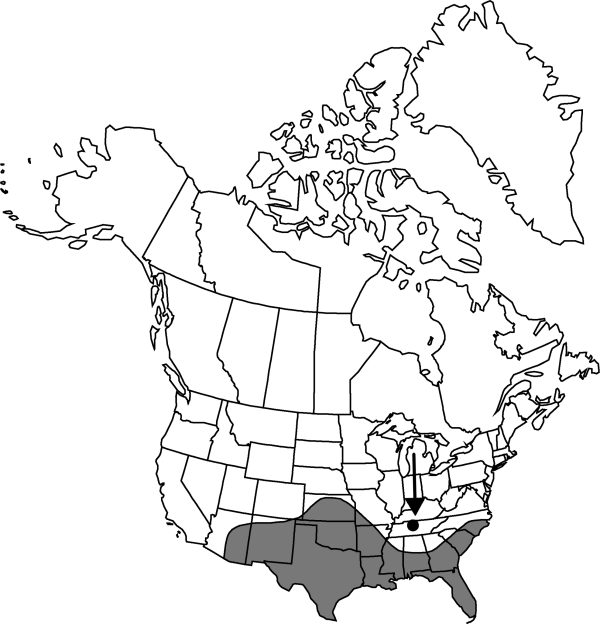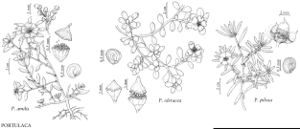Difference between revisions of "Portulaca pilosa"
Sp. Pl. 1: 445. 1753.
FNA>Volume Importer |
FNA>Volume Importer |
||
| Line 19: | Line 19: | ||
}}<!-- | }}<!-- | ||
| − | --><span class="statement" id="st- | + | --><span class="statement" id="st-undefined" data-properties=""><b>Plants </b>annual; roots fibrous to slightly fleshy. <b>Stems</b> prostrate, suberect to erect, succulent; trichomes conspicuous at nodes and in inflorescence; branches 3–25 cm. <b>Leaf</b> blades linear to oblong-lanceolate, terete to hemispheric, 5–20 × 1–3 mm, apex acute; involucrelike leaves 6–9. <b>Flowers</b> 5–12 mm diam.; petals dark pink to purple, obovate, 3–5(–7) × 1.5–3 mm; stamens 5–12(–37); stigmas 3–5(–6). <b>Capsules</b> ovoid, 1.5–4.3 mm diam. <b>Seeds</b> black or leaden, orbiculate (0.4–)0.5–0.6 mm diam.; surface cells loosely arranged, short-tuberculate and stellate to rounded-stellate; tubercles long or absent. <b>2n</b> = 8, 16.</span><!-- |
-->{{Treatment/Body | -->{{Treatment/Body | ||
| + | |phenology=Flowering late spring–early fall, year-round in s Fla. | ||
|habitat=Dry soils, beaches, disturbed habitats, roadsides and railroads on limestone, granitic, and sandstone outcrops | |habitat=Dry soils, beaches, disturbed habitats, roadsides and railroads on limestone, granitic, and sandstone outcrops | ||
|elevation=0-2000 m | |elevation=0-2000 m | ||
| Line 41: | Line 42: | ||
|basionyms= | |basionyms= | ||
|family=Portulacaceae | |family=Portulacaceae | ||
| + | |phenology=Flowering late spring–early fall, year-round in s Fla. | ||
|habitat=Dry soils, beaches, disturbed habitats, roadsides and railroads on limestone, granitic, and sandstone outcrops | |habitat=Dry soils, beaches, disturbed habitats, roadsides and railroads on limestone, granitic, and sandstone outcrops | ||
|elevation=0-2000 m | |elevation=0-2000 m | ||
| Line 48: | Line 50: | ||
|publication year=1753 | |publication year=1753 | ||
|special status= | |special status= | ||
| − | |source xml=https://jpend@bitbucket.org/aafc-mbb/fna- | + | |source xml=https://jpend@bitbucket.org/aafc-mbb/fna-data-curation.git/src/9216fc802291cd3df363fd52122300479582ede7/coarse_grained_fna_xml/V4/V4_1016.xml |
|genus=Portulaca | |genus=Portulaca | ||
|species=Portulaca pilosa | |species=Portulaca pilosa | ||
| − | |||
| − | |||
| − | |||
| − | |||
| − | |||
| − | |||
| − | |||
| − | |||
| − | |||
| − | |||
| − | |||
| − | |||
| − | |||
| − | |||
| − | |||
| − | |||
| − | |||
| − | |||
| − | |||
| − | |||
| − | |||
| − | |||
| − | |||
| − | |||
| − | |||
| − | |||
| − | |||
| − | |||
| − | |||
| − | |||
| − | |||
| − | |||
| − | |||
}}<!-- | }}<!-- | ||
-->[[Category:Treatment]][[Category:Portulaca]] | -->[[Category:Treatment]][[Category:Portulaca]] | ||
Revision as of 14:55, 27 July 2019
Plants annual; roots fibrous to slightly fleshy. Stems prostrate, suberect to erect, succulent; trichomes conspicuous at nodes and in inflorescence; branches 3–25 cm. Leaf blades linear to oblong-lanceolate, terete to hemispheric, 5–20 × 1–3 mm, apex acute; involucrelike leaves 6–9. Flowers 5–12 mm diam.; petals dark pink to purple, obovate, 3–5(–7) × 1.5–3 mm; stamens 5–12(–37); stigmas 3–5(–6). Capsules ovoid, 1.5–4.3 mm diam. Seeds black or leaden, orbiculate (0.4–)0.5–0.6 mm diam.; surface cells loosely arranged, short-tuberculate and stellate to rounded-stellate; tubercles long or absent. 2n = 8, 16.
Phenology: Flowering late spring–early fall, year-round in s Fla.
Habitat: Dry soils, beaches, disturbed habitats, roadsides and railroads on limestone, granitic, and sandstone outcrops
Elevation: 0-2000 m
Distribution

Ala., Ariz., Ark., Fla., Ga., Kans., La., Miss., Mo., N.Mex., N.C., Okla., S.C., Tenn., Tex., Mexico, West Indies, Central America, South America.
Discussion
Portulaca pilosa is a highly variable species. It exhibits morphologic variability during development, with immature plants having wider (to 4 mm), longer, and flatter leaves than mature specimens. Mature leaves are narrower, shorter, and hemispheric or terete in cross section. The Linnaean drawing of the type specimen may be an immature plant. Morphologic variability also occurs in relation to habitat differences over the large geographic range of this species. Plants growing in dry habitats have the greatest density of hairs; plants growing in moist habitats are less pilose. Plants with very dense hairs on old growth will, under more moist conditions, produce new growth with fewer hairs. Growth habit is also affected by habitat. Plants growing in warm, moist environments tend to branch quickly into a spreading habit, with erect growth following secondarily. Plants in cool, dry habitats grow erect first, then branch more slowly; the plant then has a compact habit. Specimens from Alabama, Arizona, Florida, Louisiana, Mississippi, New Mexico, and Texas exhibit all morphologic conditions. Those from Arkansas, Kansas, Missouri, and Oklahoma usually occur in shallow, sandy soils, often on rocky outcrops, and are often highly branched, compact, short, and not very pilose.
Selected References
None.
